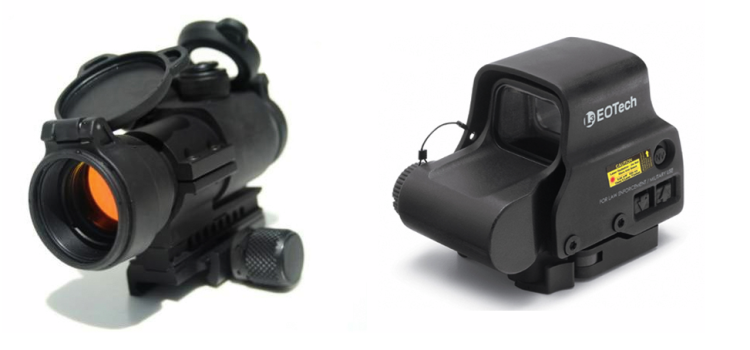The close quarter battle optics market has exploded in the last decade. Optic companies like Eotech, Aimpoint, Trijicon, and dozens of others have made massive strides in the market, producing optics for the military, state and federal police forces, hunters, competitors, and of course the home defense market. With the options out there being so varied it’s important to know the difference between the two classes of close quarter battle optics. They fall into two classes, red dot optics, and holographic sights.
So, in this article we are going to discuss, compare holographic and red-dots optics and see which one comes out on top. Of course, each holographic sight and red-dot can be different and may and may not follow the traditional features of a that category , so before you make the final purchase make sure to check out rifle optic reviews to get to know more about specific model.
Shared Features.
Red dot sight and holographic optics shared a number of features, and, of course, are designed to be used in similar roles. Both holographic and red dot optics excel in close quarters combat, in both inside and outside environments. Both style optic is electronic and relies on either a battery or an external fiber optic and tritium source. Both styles of optic are faster and easier to use than iron sights, and both are used by the military.
Red Dot Sights
Red dot sights are very simple, to both use, and in function. They use a simple dot as their reticle and while they are always called red dot sights, the dot can actually have some variation. The dot can be amber, green, or red, but red is the most prevalent colors for these optics. Red dot sights are very simple, and often barely sip the battery. The battery life for a red dot optic is often incredibly long. The most popular red dot sight are night compatible, and work well with magnifiers.
Holographic Sights
Holographic sights, most notably Eotech designs, are more complicated and more versatile than red dot optics. Holographic optics typically use a square view window. Holographic sights are often as dependable and as strong as a red dot optic. Holographic sights can and often are compatible with night vision devices and magnifiers. Holographic sights are compatible with a variety of weapons, but most use a specific reticle for a specific weapon.
<script async src="//pagead2.googlesyndication.com/pagead/js/adsbygoogle.js"></script> <!-- EpicTactical Responsive --> <ins class="adsbygoogle" style="display:block" data-ad-client="ca-pub-6322371667784146" data-ad-slot="4109136348" data-ad-format="auto"></ins> <script> (adsbygoogle = window.adsbygoogle || []).push({}); </script>Comparing The Two
Versatility
Both optics are designed for target engagement from 5 feet to 200 yards, depending on the user’s shooting ability of course. Holographic optics like the Eotech offer a much more versatile optics. For close range encounters the Eotech’s large outer circle excels for extremely close range fighting, think room to room fight. The user simply fills the circle with the target and starts pulling the trigger. The inner, small dot can used for precision shooting, and is designed to be used for a target between 50 and 100 yards when used with appropriate caliber and barrel length.
A red dot reticle is very, very simple, it’s a red dot. Users simply the dot on their intended target and start pulling the trigger. Small red dots are easier to use at longer ranges, and larger dots work better at close ranges, so you’re stuck with whatever MOA dot you choose. The red dot sight can be thrown on any weapon you have, though, it works the same on the rifle as it does on a shotgun, submachine gun, or even heavy machine gun.
Battery life
The simple red dot reticle makes it possible for an extremely long life when it comes to red dot optics, how long? Well, the Aimpoint Comp M4s can last eight continuous years with the optic turned on. Some optics can last 50,000 hours, with the shortest lasting 15,000. When compared to an optic like the Eotech and it’s 1,000 hours of continuous use you see the immediate advantage of the simple red dot reticle.
Ease of Use
When compared side by side the easier optic to use is clearly the red dot optic. Put the red dot optic on target and start the party right? Well, mostly that’s true. The simple red dot optic requires almost no training, some simple instruction, maybe ten minutes, and then range time. So for a beginner, the red dot sight is ultimately easier to use.
A holographic reticle can be much more complicated. Instead of a red dot, you may have the Eotech XR308 or MOA reticle. Both will require some explanation on how it is supposed to be used, and how to effectively engage your target.
The quencher is that at longer ranges, after training with an Eotech, it’s easier to hit your target. so someone with some additional experience, and the time to learn the optic will find the holographic sight easier to use in a variety of shooting situations.
On the Additional Subjects.
Some may ask what about reliability? Durability? Cowitnessing, zeroing, etc? Those topics are largely dependent on the actual models of the sights, not the category. An Aimpoint may be more durable than an Eotech, but an Eotech is going to be more reliable and durable than a big box store 39 dollar, red dot sight. The categories I used is where you’ll see the main differences between the two styles of optics.
The winner you may ask? Not every person will ever agree on one winner, but I believe a holographic optic is better overall. In terms of versatility, and ease of use for longer range shooting the holographic comes out on top in my experience. Your mileage may vary.
Image curiosity of: http://fmj556x45.tumblr.com

